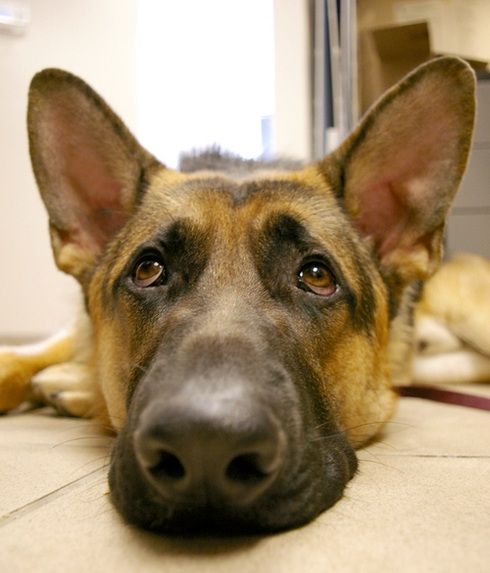Here we go through different tactics, what we can use, to remove gum and other sticky stuff from your German Shepherd’s coat.
How many times have you gone for a walk and stepped in gum someone spit out on the sidewalk? It’s tough to get gum off the bottom of your shoes; it can be just as hard to get it out of your German Shepherd’s coat.
Many groomers recommend applying ice to the gum or sticky stuff before attempting to remove it. Place your hand or something else between the ice and your dog’s skin while trying to freeze the gum. When the gum is very cold or frozen, try
to break it out of the coat. You may have to reapply the ice several times as you’re working at it.
You also may be able to use a small amount of vegetable oil to remove the gum. Massage the oil into his coat around the gum with your fingers. Then see if the gum will slide out. Of course, now your German Shepherd will need a bath to get the oil out of his coat.
Sometimes the only thing you can do is trim the sticky stuff out of the coat. If you need to do this, trim carefully so you don’t cut your puppy’s skin.
Slide a comb between the sticky stuff and his skin, without pulling up his skin. Then trim on the outside of the comb, away from his skin. Snip very slowly and in tiny cuts so you don’t make a mistake.
Getting Out Glue
If your German Shepherd gets glue, hot glue, or other adhesives into his coat, they are not going to come out easily. The glue will clump with his hair and make a sticky mess.
Wearing rubber gloves so you don’t end up stuck to your dog, try to wash out as much as you can. Use Joy soap to wash, rinse well, and follow with a vinegar rinse (2 cups white vinegar to 1 gallon warm water), as for gum and sticky stuff.
Then trim out any remaining glue. After you’ve trimmed his coat, you may want to wash that spot in his coat again just in case any glue remains.
Removing Burrs, Foxtails, and Seeds
In the spring and summer, grass and weed seeds can be incredibly annoying to dogs and dog owners. Although your German Shepherd’s coat doesn’t pick up the seeds as much as fluffier dog coats do, the seeds are designed to stick.
Most have barbs or hooks that latch onto the coat. Then, as the dog moves, the hooks and barbs grab more hairs, and soon a tangle forms. If the seed gets into your German Shepherd’s paw between the pads, those barbs and hooks hurt.
You can pull out many grass and weed seeds from your puppy’s coat. Just be careful you don’t get a barb in your fingertip.
If the seeds won’t pull out, you may be able to brush or comb them out. If the seeds don’t brush out, use a little hair conditioner—a good, thick, slippery kind—to work out the tangle and seed. Then rinse out the conditioner.
If you still have a tangle with the seed in it, you’ll have to trim it out.
TIPS
After a hike, check your German Shepherd’s coat for foxtails. Be sure to check between his toes, under his tail, in his mouth, in his ears, and under his legs. If foxtails aren’t removed, they can dig into his skin or even migrate to his lungs and cause a serious abscess.
Dealing with Porcupine Quills and Cactus Spines
Porcupine quills come in different sizes and forms, depending on the species of porcupine they came from. When touched by another animal, the quill releases from the porcupine’s skin and embeds itself in the other animal’s skin.
Cactus spines don’t always detach from the plant, again depending on the species, but many are barbed. When they make contact with skin, they don’t pull out but rather work deeper into the skin.
Don’t try to pull out porcupine quills or cactus spines on your own—they’re very painful. Take your dog to the vet instead. Most veterinarians recommend sedating the dog before removing these stickers. This is especially true if the dog got them in his face or paws or has a lot of them.

